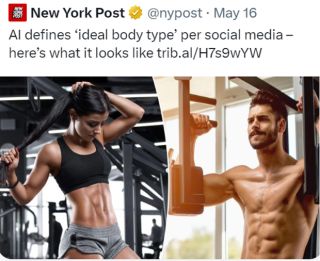Body Image
AI Confirms Our Unrealistic Body Ideals
What AI regards as the ideal body type and why it's so probematic.
Posted May 23, 2023 Reviewed by Gary Drevitch

by Heather Widdows, University of Warwick, and Jessica Sutherland, University of Birmingham
Last week the New York Post reported on what artificial intelligence (AI) purportedly regards as the ideal body type, drawn from the engine's interpretation of social media (left). The article draws on the Bulimia Project’s research project Scrolling Into Bias which aimed to understand what the "ideal" body types promoted on social media actually look like. If you have spent any time on social media – especially Instagram – it won’t surprise you that the ideal body is one which bears little resemblance to how most flesh-and-blood human beings actually look. Even the most prominent action-movie stars rarely measure up to the gym-bunny, visible muscles which are on display: Both the ideal man and the ideal woman, as pictured in the post, have truly impressive six-packs. The woman pictured is particularly hard to emulate, with both defined muscles and an exceptionally tiny waist reminiscent of Barbie’s or that of the Disney princess Elsa from Frozen.
The Post article opens with the phrase “Artificial intelligence has its own idea of what the perfect human body should look like.”[1] Except, of course, this isn’t quite accurate because artificial intelligence (AI), at least for now, doesn’t have original ideas – at least not in this sense. All AI can do is to learn from the data it can gather; in this instance, a vast data scoop from social media. What this tells us, then, is not what AI think is the ideal body, but what we – or at least those of us who use social media – think is the ideal body.
In Perfect Me (2018), Widdows tracked the trends around the ideal body and argued that the emerging beauty ideal is now global. This differes from previous ideals, as only a global ideal can be naturalising and normalising, making us all engage more, just to be good enough—or making us ashamed of our failing bodies if we don’t. The global ideal, it turns out, has four features, no matter where you are in the world or what demographic: Thin, Firm, Smooth, and Young.
Thinness can come in many forms, and increasingly ‘thin with curves’ is the ideal, although not everywhere and not always. But everywhere this ideal requires thinness, or relative thinness, in some places, most obviously waists and ankles. Firmness is the second feature, which, while allowing for curves, is in fact more demanding as body work is required — either diet and exercise to the get the right curves in the right places, or surgery on an otherwise thin frame. Firm curves are harder to get than thinness alone: “a large, saggy, pockmarked and cellulite-dimpled backside attached to ‘thunder thighs’ and ‘cankles’ is not ideal”.[2]
These four features of the global beauty ideal are becoming increasingly harder to achieve, in part driven by technological advances in filters, photo editing, and cosmetic procedures. As the Bulimia Project noted, “In the age of Instagram and Snapchat filters, no one can reasonably achieve the physical standards set by social media." And these features show in abundance in the AI-created ideal. Wholly unsurprisingly 40% of the AI-generated images overall depicted “unrealistic” body types—37% of the images of women and 43% of those of men.[3]
The Post reporter seems surprised that more than half of the images of women (53%) had olive skin as did 63% of those of men.[4] But this is not surprising, and only confirms the claim made in Perfect Me that the ideal skin tone is now the global mean of “golden or bronze glowing skin”.[5] And for all our panic about surgery trends some of the most damaging beauty practices are tanning and skin-lightening. We know that tanning leads to cancer, and that skin lightening is deemed a public health risk by the World Health Organisation. Yet – and this is the only "real" bit of diversity when it comes to bodies – all skin tones are now acceptable if, and only if, you have the other features of the ideal: thin (with curves), firm, smooth and young.
AI is a mirror on ourselves. We should not be horrified or surprised with what this study shows, but perhaps we need to recognise that it’s our own aspiration to be impossibly perfect which needs attention.
References
[1] https://nypost.com/2023/05/16/ai-defines-ideal-body-type-per-social-med…
[2] Widdows, Heather Perfect Me: Beauty as an Ethical Ideal, Princeton University Press, 2018, p.23
[3] https://bulimia.com/examine/scrolling-into-bias/
[4] https://bulimia.com/examine/scrolling-into-bias/
[5] Widdows, Heather Perfect Me: Beauty as an Ethical Ideal, Princeton University Press, 2018, p.86


